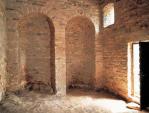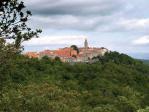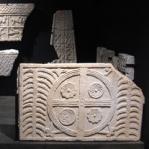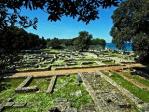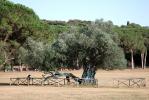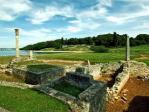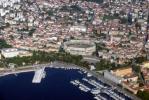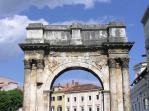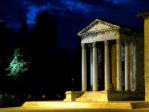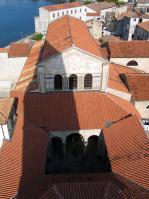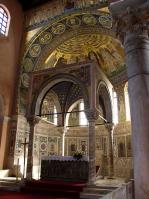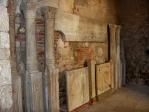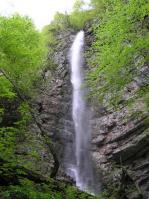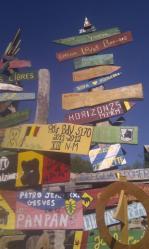text source: http://business.croatia.hr/hr-HR/Hrvatska-turisticka-zajednica/Promo-materijali/Brosure
other sources are mentioned beneath the texts.
other sources are mentioned beneath the texts.
Palace Soardo - Bembo in Bale
Keywords: renaissance, palace, fortification
Region: Istra
Nearest town: Pula
Content: Fortification
The largest building in Bale is Palace Soardo - Bembo. For the beauty of it's recently renovated Gothic- Renaissance facade, it attracts the attention of all who stop by in the city.The fortified castle of Soardo family changed the purpose in the 15th century and became a place of residence. In the 16th century castle owners became members of the family Bembo which was used to organize numerous social events in the Palace.
http://www.bale-valle.hr/defaultd.asp?id=19&cat=42
Castle – Fortification in Funtana
Keywords: cultural monument, renaissance
Region: Istra
Nearest town: Pula
Content: Fortress
Castle – Fortification in Funtana
The Funtana castle is a protected cultural monument. Bernardo Borisi had it built “four miles away from Poreč and two from Vrsar” in the 1610, as engraved in Latin language on the doorway of the castle:vb“In Thee Lord I trust.”
In the 1610 the noble Bemardo Borisi from a famous Duklean and Bar family Borisi had it constructed.
It is a castle-fortification of renaissance characteristics, rebuilt in baroque when additional windows were opened. The castle was the first building in Funtana and then the village grew around it.
Some historians like to mention the possibility of an earlier, late medieval architecture on the spot where the castle was built.
The interior of the castle is not open to visitors.
http://www.funtana.com/en/funtanas-sights/
The Old Christian Basilica in Vrsar
Keywords: romanesque, remains, old christian building
Region: Istra
Nearest town: Pula, Rijeka
Content: Sacral monuments and leftovers
The Old Christian Basilica in Vrsar
Next to the Romanesque basilica of St. Mary, in the walled-in backyard, there are remains (foundations and mosaic floor fragments) of the Old Christian basilica dating from the 4th century. Nowadays the remains of the basilica are covered with earth and are not accessible to the public. This was one of the oldest Old Christian buildings in Istria. First Christians in Vrsar (2nd or 3rd century) performed their religious ceremonies presumably in some private houses. The basilica was probably built in the 4th century, after the emperor Constantin the Great (306-337) had by the Milan edict permitted the Christians to profess freely their religion. Fragments of the basilica were excavated in August and September of 1935 by the Italian archaeologist Mario Mirabella Roberti. The basilica had a rectangular ground-plan and resembled the basilicas of the first phase of the Old Christian architecture. The baptistery (baptisterium) was also a part of the basilica, as well as the entrance-hall (nartex) on the west side. In the 6th century the basilica was enlarged by an apse (semicircular recess on the back side). The floor was covered with polychromatic mosaics. The mosaics have been preserved only in fragments, but one can still imagine their artistic entirety. They are decorated with very interesting Old Christian iconography, mostly with floral (leaves, wreaths, baskets with grapes) and animal motifs (fish, peafowls, pigeons). Images of fish originating from the Istrian sea are proof of the mosaics having been made in some Istrian artistic workshop. On them the four seasons are symbolically represented. The central mosaic field consists of 73 circles connected to each other by tresses. As to their artistic characteristics, the mosaics resemble the ones in the Theodoric’s basilica in Aquileia dating from the year 324.
During invasions of the Slavs (Croats) to Istria at the beginning of the 7th century the basilica was demolished and a part of it transformed into an olive mill. Archaeological finds include Roman tegulas (tiles), coins, lucernas (lanterns) etc.
By all means, the mosaics should be excavated and presented to tourists and visitors.
http://infovrsar.com/vrsar/history/cultural-monuments/?lang=en
Labin - medieval town
Keywords: medieval, history, architecture
Region: Istra
Content: Architecture
The medieval town of Labin is situated on the hill above Rabac. Its old name of Albona was first mentioned in 285 AD. The birthplace of Matthias Flacius Illyricus, the reformer and collaborator of Martin Luther, it is a cultural and administrative center today. The rich cultural and architectural heritage of Labin is enlivened by number of art ateliers and by the bustling youth gathering in the coffee bars scattered around the old town. The Sculpture Park in nearby Dubrova features over 70 forma viva stone sculptures.
After a walk through the narrow streets of the Old Town, pay a visit to the Town Museum with its archaeological and unique in this part of Europe, a miniature coal mine. Have a look at the Memorial collection of Matthias Flacius Illyricus, peek into the art ateliers, enjoy the view of Rabac and Cres island from the Fortica or pop into the small, elegant shops and take refreshments on one of the terraces of the local coffee bars.
Novigrad's city walls
Keywords: walls, ancient
Region: Istra
Nearest town: Pula
Content: Architecture
The city walls have for centuries embraced and protected Novigrad’s rich history, its culture and valuable traditions. In fact the first written reference to the city goes back to the distant 599 A.D. Novigrad was founded on the grounds of several villages that are known to have existed on this same land in the past- Neapolis in the Seventh century, then Civitas Nova in the Ninth century, and ancient Emona (Aemonia) in the 12th century. All of this states the fact that Novigrad’s background is filled with a rich and very turbulent past.
Lapidarium Museum in Novigrad
Established several years ago and managed by a team of young professionals, Lapidarium Museum has helped usher Novigrad into a new millennium that poses novel challenges to towns in presenting their cultural heritage.
The building housing the museum is in itself a curiosity. It is designed as two black boxes set in a park of green. The use of glass panels lends the building an air of transparency and accessibility. Although a masterpiece of modern design, the new museum blends perfectly with the old town centre that surrounds it.
Lapidarium Museum houses one of the most important collections of stone monuments in Croatia. Numbering about 100, the monuments hail from the first to the eighteenth century. Half of the monuments, mostly representing elements of church architecture from the Parish Church of St. Pelagius, are part of the museum’s permanent exhibition.
The museum’s most interesting exhibit is the ciborium of Bishop Mauritius, dating from the end of the eighth century. Originating in the parish church, it was built during the time of the Frankish state and its famous ruler Charlemagne, when Novigrad was the centre of the diocese and secular Frankish rule.
Brijuni National Park
Brijuni National Park, the main pearl of the natural heritage of Istria. In the park are especially valuable monuments of Antiquity, such as Roman villas and complexes and fortresses from the time of the Austro-Hungarian Empire. Among them is the most magnificent fortress on the island of Mali Brijun, which now occasionally serves as a stage for theatrical performances. The archipelago of Brijuni is an extraordinary blend of natural, historical and cultural heritage. The mild climate and the favourable geographical conditions, deep retracted bays and easily defendable elevated fortifications, have secured a continuum in the human activity on the island from a pre-historic age until the present day. On a relatively small archipelago, of an area of around 7km2, have been registered some hundred sites and buildings of archaeological and cultural-historical value and which comprise the period from the first Neolithic settlements, the dugouts in the bay of Soline, until the creation of an elite summer and health resort at the beginning of the last century and the presidential residency visited by statesmen from one third of the world’s countries in its 25 years of existence (1954-1979).
This concise curriculum vitae of the island, which carefully preserves the traces of 5000 years of human history, makes the legend of its creation even more real and when arriving to the island a part of Heaven discloses in front of our eyes in the unique harmony of the island’s flora, fauna and heritage. A unique bland of the green islands sank into the turquoise-blue sea whose bays and hills are laced with the white Istrian rocks.
Amphitheatre in Pula (and other leftovers from Roman Empire)
Content: Antique leftovers
The largest town in Istria, PULA, is located in the extreme South of the Istrian peninsula and at first glance does not imply the cultural richness which it hides, and the beauty of its surroundings. The reason for this is its location in the plains, the size of the town and the buildings on its edges. If we enter into the centre of town, we will immediately be impressed by the monumental and well preserved amphitheatre, which testifies to the extraordinary importance of Pula and Istria since ancient times. This is the sixth largest Roman amphitheatre in the world and also one of the best preserved. The amphitheatre was built during the reign of Emperor Vespasian in the first century after Christ, and its appearance has remained virtually unchanged for two thousand years. It once served as an arena for cruel gladiator fighting which was watched by up to 20 000 people, and today serves as a tourist attraction and as a stage for various events, most of which are musical performances - from classical music and ballet to rock concerts, which favours a unique atmosphere and the acoustics of the arena. However, the most famous of all national events is the international film festival held in July each year. In addition to the amphitheatre in Pula, there are many other monuments from the Roman period, such as the Arch of the Sergi in the city centre, Temple of Augustus, Gate of Hercules, small Roman theatre, Forum, Twin Gates and City Walls ... One of the most important museums in Croatia - the Archaeological Museum of Istria is also located in Pula. It holds the largest number of archaeological finds in Istria, dating from pre¬historic times to the Middle Ages. Many monuments, particularly from recent times, are held in the Historical Museum of Istria and also in small galleries. Interesting pictures and graphics can be found in the impressive building of the City Council, par¬ticularly from the time of the Austro-Hungarian Empire, when Pula was one of the largest military ports in the world.
Other amenities:
- Castle - a star-shaped castle with four bastions was built in 1630
- Communal Palace - during the Venetian rule it was the seat of the duke and provveditore, and until the present has remained the seat of the mayor
- Cathedral of the Assumption of the Blessed Virgin Mary - It was built at the site where Christians gathered already in the time of their persecution (until the 4th century). With the ages it grew larger and assumed its present-day shape in the 5th century
- Chapel of St. Maria Formosa - it is one of the two chapels built in the 6th century as part of a large Benedictine abbey demolished in the 16th century
- Orthodox Church of St. Nicholas - built in the second half of the 6th century, with a typical Ravenna-like polygonal apse, the church was dedicated to the Blessed Virgin Mary
- Naval cemetery - the Naval cemetery, dating from 1866, is the site where 150,000 soldiers from the Austro-Hungarian Monarchy (until 1918) were buried
Church of St. Euphemia in Rovinj
Content: Sacral monuments and leftovers
Istria's cultural richness and the beauty of her heritage are present throughout this magical peninsula, and are perhaps most apparent in the town of ROVINJ. The panorama of Rovinj with the church of St. Euphemia and the bell tower in the centre is one of the most impressive symbols of Istria. The beauty of Rovinj has long been attracting many artists inspired by its magical views, preserved old town houses and picturesque narrow streets of the old part of town. Among these streets, Grisia has a special place, as the artists who gather there traditionally offer their works to many tourists on the spot. Museum of Rovinj in the Baroque building in the centre of the main city holds many paintings by old masters. There are works of artists from the 19th century, inspired by life in Rovinj, particularly from the period of the Austrian authorities, when Istria was a strategically very important part of the once powerful Habsburg Empire.
EUPHRASIAN BASILICA in Porec
Content: Sacral monuments and leftovers
EUPHRASIAN BASILICA in Porec, for now the only monu¬ment in Istria listed on the UNESCO World Heritage List. The basilica is named after Bishop Euphrasius, in whose time it was built on the foundations of an even older basilica. It is the period of the basilica's construction that is one of the main reasons for its value, as from that early period of Christian history, there are almost no completely preserved monuments. It is unique and special in its style of construction and a splen¬did example of early Byzantine art of the 6th century, which is rarely found so far to the West, the result of a well organized government of the famous Byzantine Emperor Justinian, who was ruler at the time of restored power, after the fall of the Ro¬man Empire.The Basilica is almost invisible from the outside because it blends into the urban struc¬ture of the old city centre of Porec. Yet if we enter into its interior, we will im¬mediately be impressed by the uniqueness of its structure, and in particular the splendor and uniqueness of the altar. Like other Byzantine churches of that era, it is embellished with rich mosaics, and the best preserved are on the apse of the church and in a special collection in the whole complex of the basilica. Among them, the most famous is the mosaic of the fish, a historical symbol of Christ, which serves as a sort of symbol of Porec, which is therefore sometimes called the city of mosaics. Porec, of course, is not only defined by the basilica, but also by its picturesque urban core which holds other beautiful and well preserved buildings from ancient times. Like other cities in Istria, Porec also has a local History Museum. In this museum, paintings have a special role, with the most valuable part of the collection belonging to the once powerful and rich family Carli
Interesting routes
To residents of the area, Nature Park Škarline is an inseparable part of local identity and holds an indelible place in the collective mind. Visitors to the area sometimes fail to discover this perfe...
The entire Vinodol is a beautiful story, composed of rich history, numerous cultural and historical monuments, natural resources and tradition. It is one thing to experience Vinodol by passing through...
Devil's passage, Green vortex and caves Muževa kuća, even as far back as 1962, were declared a special geomorphological reservation with area of about 200 ha. Today the area of the Green vorte...
The Velebit shelter for bear cubs
Velebit association Kuterevo was founded in 1995 with the aim of preserving the wild life of Croatian highlands.
In year 2002, Velebit association Kuterevo and the Cr...

